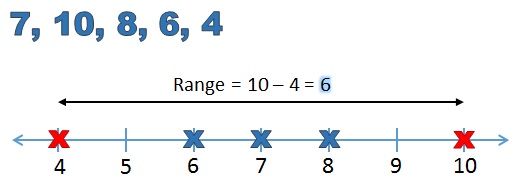Finding the Range
(KS2, Year 4)

How to Find the Range
The range is found by subtracting the lowest number in a set from the highest number.Question
What is the range of the test scores below?Step-by-Step:
1
List the numbers in numerical order (going from the smallest to the largest number).
7 10 8 6 4 → 4 6 7 8 10
2
Find the lowest number in the set.
4 6 7 8 10
The lowest test score is 4.
3
Find the highest number in the set.
4 6 7 8 10
The highest test score is 10.
4
Subtract the lowest number (4) from the highest number (10).
10 − 4 = 6
Answer:
The range of the test scores is 6.
A Formula to Find the Range
The formula for finding the range is shown below:- xmax is the highest number in the set.
- xmin is the lowest number in the set.
How to Find the Range from a Number Line
Finding the range of a set of numbers on a number line is easy. If we plot the test scores on a number line (with the highest and lowest scores in red), the range is the distance between the highest and lowest numbers on the number line: The range is the distance between the highest and lowest numbers on the number line. In our example, it is 6.
The range is the distance between the highest and lowest numbers on the number line. In our example, it is 6.
How to Find the Range from a Frequency Table
Sometimes data is presented in frequency tables. A frequency table representing the test scores is shown below: It is possible to find that the range of the test scores is 6.
finding the range from a frequency table
It is possible to find that the range of the test scores is 6.
finding the range from a frequency table
Beware
Be Careful When the Lowest Number is Negative
Be careful when the lowest number in a set is a negative number. Let's find the range of the following numbers:
−2, 0, 3, 4, 6
The range is found by subtracting the lowest number (−2) from the highest number (6):
Range = 6 − (−2)
Don't forget: Subtracting a negative number is equivalent to adding the (positive) number. (Two negatives make a positive!)
Subtracting −2 is equivalent to adding (+)2:
Range = 6 − (−2) = 6 + (+2) = 6 + 2
Range = 8
Worksheet
This test is printable and sendable






